
The La Crosse Housing Authority, 1946-1985
(written by Jenny DeRocher, Archives staff)
In her book about the history of the La Crosse Housing Authority, local historian Susan Hessel explained the national and regional trends that led to large-scale housing shortages in 1940s La Crosse. According to Hessel’s research, between 1920 and 1930, La Crosse’s population grew 30.2% (while the average growth in Wisconsin was 25.8%).
But during U.S. involvement in WWI (1917-1918), building supplies were rationed and there were fewer carpenters working. When the war ended, there was a huge building boom, causing the price of materials to increase. Hessel reported that building costs increased by 112% in 18 months, and suddenly few people could afford these newly-built homes. The 1929 stock market crash was in part caused by these high prices and the mortgage rates at the time. Then, between 1929 and 1934, over 1 million families lost their homes across the U.S.
It took years for families to recover from the Great Depression. When the U.S. joined the Allied forces during WWII, millions of young men and women were away from the homefront. When they returned, many expected to begin their adult life by buying a home with their new spouse. But instead, WWII veterans found a massive housing crisis had gripped the nation. According to the 1940 U.S. Census Housing Statistics, the city of La Crosse had a total of 12,103 dwelling units for a population of 42,707.
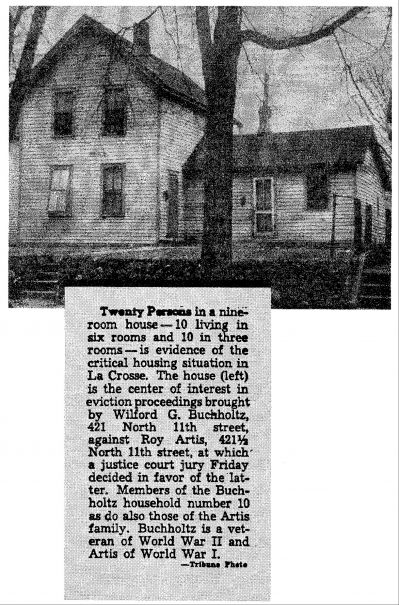
From page 2 of Susan Hessel's book, “…We need a roof over or heads”: The Story of the La Crosse Housing Authority (1998).
By January 1946, the Citizens Emergency Housing Committee was formed in La Crosse to study housing insecurity, and the La Crosse Housing Authority was quickly established that same month. The committee's study found that 1300 veterans’ families were housing insecure.
Over the course of the next 40 years, the La Crosse Housing Authority completed 12 public housing developments. Today, the La Crosse Housing Authority continues its mission to maintain these properties to “promote adequate and affordable housing, economic opportunity and a suitable living environment free from discrimination.
To learn more about the history of the La Crosse Housing Authority, read Susan Hessel’s book, “…We need a roof over or heads”: The Story of the La Crosse Housing Authority (1998), which is accessible online here.
Housing Authority Developments, 1949-1983
The Green Bay Street Housing Project (the area between Losey Boulevard, 21st Place, Green Bay, and Weston streets – later named the Verchota Addition), 1949
This was the Housing Authority’s first major project, meant to address the very urgent need to provide housing for the 1300 veterans’ families. This area had been utilized as La Crosse’s first airport, Salzer Field, and then had been used by the federal government during WWII to store vehicles from Camp McCoy. After the war, the Housing Authority identified this land as an ideal location to build emergency housing. Read more about the development in this 2018 LPL Archives blog.

Printed in the La Crosse Tribune on May 19, 1948, page 2. A sketched example of a home to planned for the Salzer plats.
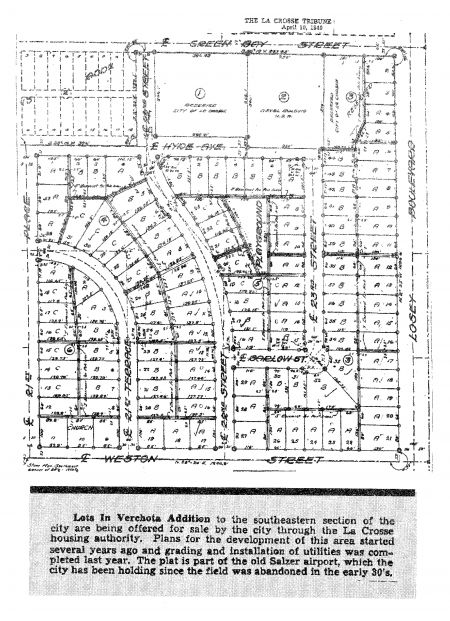
Printed in the La Crosse Tribune on April 10, 1949
Schuh Homes, 1305 St. James St., dedicated in 1959
Designed by local architect Robert Hackner, the Schuh homes were the first public housing complex built in the city, and were meant for young families. According to Sue Hessel, the Schuh homes included “74 units—14 one-bedroom apartments; 30 two-bedroom apartments; 22 with three bedrooms; six with four bedrooms; and two with five bedrooms.” Hackner earned his Master’s degree on the GI Bill himself, and was passionate about the success of public housing. He would go on to design 5,000 public housing units during his career.

Schuh Homes groundbreaking, 1958. From left to right are Robert Fowler (contractor), Harry Schroeder (of the Hackner, Schroeder, and Associates architecture firm), Frank Grover (Housing Authority Executive Director), Mayor Milo Knutson, Father Mullen (commissioner), Joel Stokke (commissioner), Reverend Stoeffel (commissioner), Joseph Becker (commissioner), Harry Huber (commissioner), Leone Oman (Housing Authority staff), and Charles Kelly (Housing Authority staff).
Stoffel Court, 333 7th St. S., dedicated in 1964

Stoffel Court, circa 1968
Also designed by Hackner, this nine-story apartment complex was named after Pastor Harold N. Stoffel, who suggested the idea to the Housing Authority that public housing be built for the senior citizens. A 1960 survey showed that this population would best be served closer to downtown, where they would have better access to” shopping, churches, and other services.”
Stokke Tower, 421 6th St. S., dedicated 1968
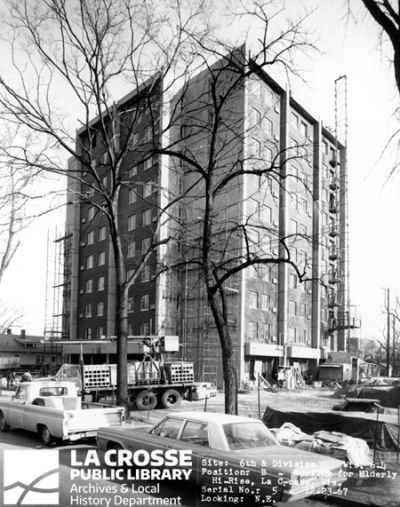
Stokke Tower, taken December 23, 1967
Demand was so high for senior public housing that shortly after Stoffel Court was finished, plans began for a 10-story, 91-unit high-rise. Named for Commissioner Joel Stokke, this building cost an extra $10,000 to have a sand-blasted structure instead of smooth concrete. Reverend Mullen wrote passionately to the Public Housing Administration to convince them the need of this expense: "Without the texturing, it is felt the concrete’s appearance is no acceptable, being cold and stark and not at all in keeping with the community’s architectural tastes.”
Mullen Homes, 1305 St. James St., dedicated 1968
According to Hessel, despite Hackner’s insistence that public housing projects should remain low-density, “the Public Housing Administration demanded and could not be dissuaded from the concept of Mullen having buildings with four and six apartments in each.” The Mullen Homes included 59 units, a mix of 2-, 3-, 4-, and 5-bedroom apartments to try and meet the high demand for larger families, which the commercial housing market was not able to meet at the time. Each cluster included children play areas catered to different age groups.
Sauber Manor, 1033 Liberty St., dedicated 1971
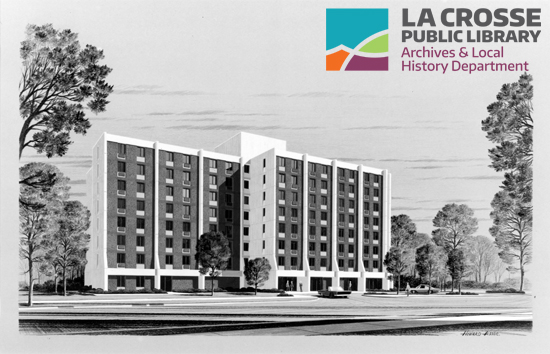
Rendering of Sauber Manor, prepared by Hackner, Schroeder, Roslansky & Associates architecture firm.
Ground broke for the North Side’s first high-rise for seniors in June 1968, before Stokke Tower and the Mullen Homes had even been dedicated. Hessel noted in her research that, “35 residents at Stoffel and Stokke were from the North Side and most preferred to live in the part of La Crosse where they grew up or had raised their families.” A lounge on the 8th floor overlooks the Black River and Minnesota bluffs.
Huber Homes, Huber Court & Gladys St., dedicated 1975
By 1970, it was clear to the Housing Authority that public housing was not always met with open arms in certain La Crosse neighborhoods. Homeowners often held the misconception that public housing would depreciate the value of their own property. South Side homeowners were especially sensitive to this. But by 1970, the Housing Authority’s research showed the need for family housing on the South Side, and they began a search for available sites.
The plan was to develop 160 units across the South Side so there were no concentrations of housing, which would help prevent overcrowding neighborhood schools. By 1971, the Housing Authority’s compromise to build low-impact housing was to build duplex townhouses that were more scattered, rather than a larger housing complex. In 1974, ground broke for 20 townhouses that would be named the Huber Homes, and were open for family housing.
Becker Plaza, 415 7th St. S., dedicated 1976

Ground breaking for Becker Plaza, 1975. In the background, you can see the Elliott Arms apartment complextowering above other homes in the neighborhood. From left to right, Roland Solberg (commissioner), Margaret Annett (commissioner), Brian Carroll (Alderman), Joseph Becker (commissioner), Mayor Patrick Zielke, Angie Wiemerslage (Housing Authority Executive Director), and Joel Stokke (commisioner).
Becker Plaza is a 76-unit building next door to Stoffel Court. The same day it was dedicated, the Housing Authority broke ground on its next big development. This high-rise was built for low-to-moderate income seniors, with two of twelve units on every floor reserved for residents with diabilities.
Forest Park, 1230 Badger St., completed 1977
Named for Forest Avenue, the road this development was built on a piece of land historically donated to the City by Joseph W. Losey for a small park.
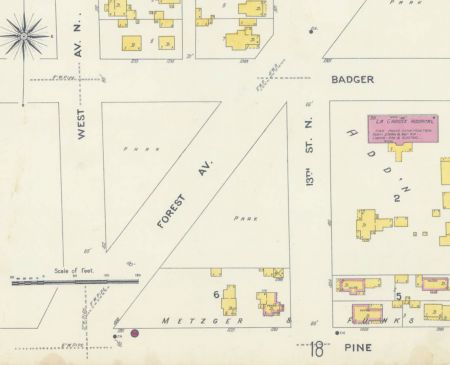
Forest Avenue, a diagonal street that ran from West Ave. to La Crosse St. no longer exists. The block between West Ave and 13th St. N. was developed in 1976 for the Housing Authority's Forest Park high rise. This image shows the 1906 Sanborn Map, which is available online here.
Originally, the plans for Forest Park included solar heating in order to be energy-efficient, but these plans were later knocked down by the U.S. Department of Housing and Urban Development, who controlled the federally-funded construction of public housing projects. The solar panels were estimated to cost $15,000 at the time, and it was predicted the building would only save $360/year on energy costs.
Grover Estates, Taylor and Hamilton streets, dedicated 1980
Built on the far North Side for low-income families, the Grover Estates include 30-unit duplexes. After the Housing Authority had purchased the land for this development, they were immediately faced with resistance from La Crosse residents who lived in the area. First, neighborhood residents successfully petitioned against rezoning the land, followed by community members and even city aldermen insisted the Housing Authority purchase land outside of the city limits for public housing. However, this was out of the question—the low-income housing had to be in the city to meet with federal guidelines.
Ping Manor, 1311 Badger St., dedicated 1981

The Ping Manor stands on a 1.6 acre parcel that the City acquired in exchange for 4 acres out of the land that the Grover Estates were developed on. The Housing Authority decided that the 300-person waitlist for senior housing took more priority over 4 extra acres of low-income family housing. In the end, the high-rise included 61 units for seniors.
Ray Ping, commissioner from 1973-1980, said he was, "flabbergasted, pleased, and a little shocked," at the decision to name this new high-rise in his honor.
Solberg Heights, 213 6th St. S., dedicated 1983
In 1981, the Housing Authority announced plans for the last senior or family housing project for "the forseeable future." This was to be Solberg Heights, a 79-unit high-rise for senior housing on 6th Street. At this point, the waiting list had increased to 450 people.
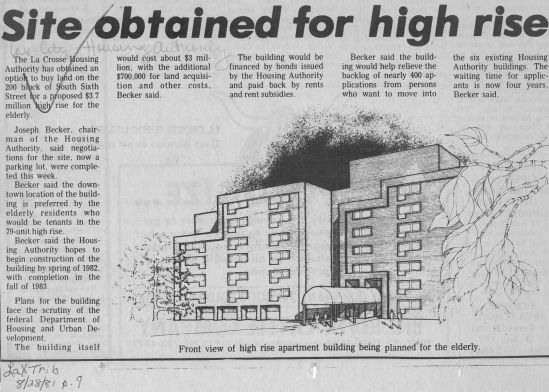
Sketch of Solberg Heights, printed in the La Crosse Tribune, August 28, 1981, page 9.
After President Ronald Regan was elected in 1980, the U.S. Department of Housing and Urban Development's buget was slashed, and by 1985, only 5,000 public housing units were developed in the U.S.
In 1985, the Milwaukee office of the U.S. Department of Housing and Urban Development awarded its first Award of Excellence in public housing managerment to the La Crosse Housing Authority. They won this award out of 191-similar sized housing authorities across the state of Wisconsin alone. That same year, it was determined that La Crosse's Housing Authority was "1 of 29 outstanding public housing programs in the nation."
In response the the 1985 awards, Mayor Zielke was quoted, "I am pleased and proud of the way that they have provided housing for so many...people in La Crosse. We would really be in dire straits today if it wouldn't be for the housing authority."
